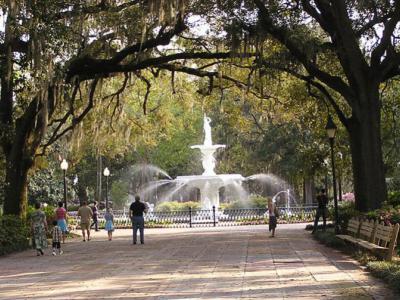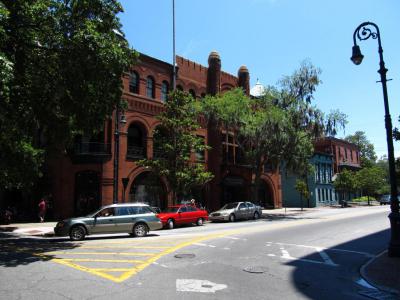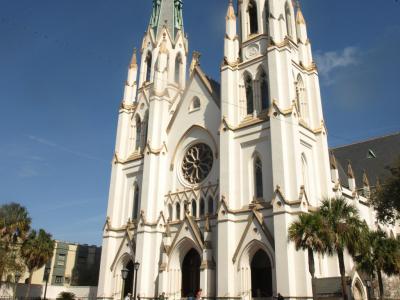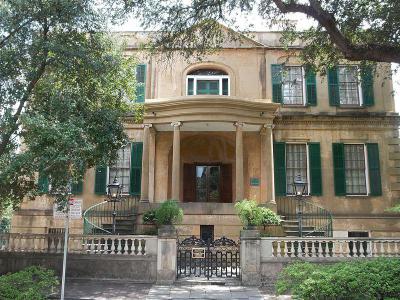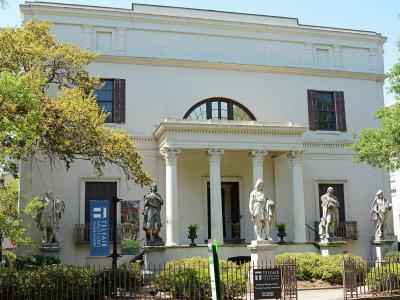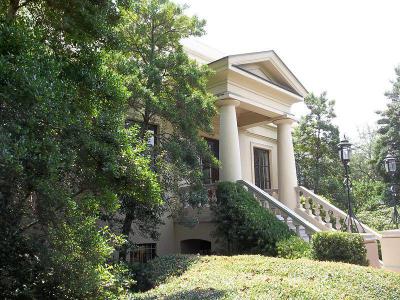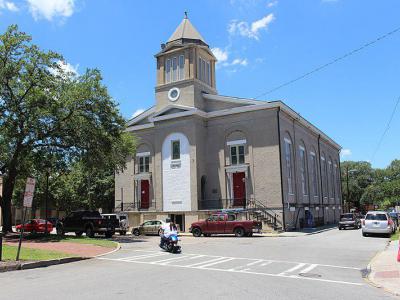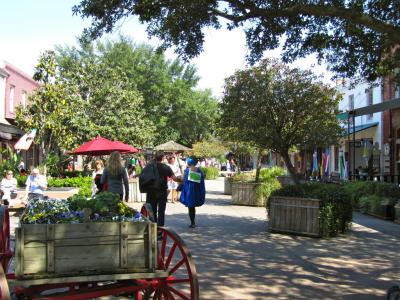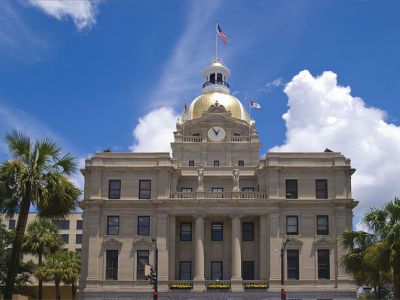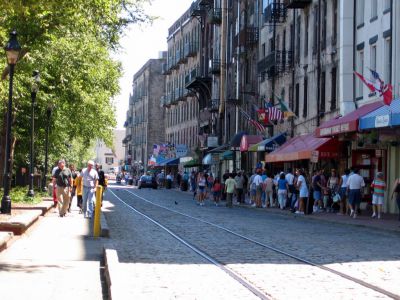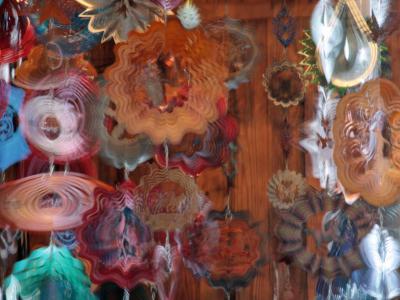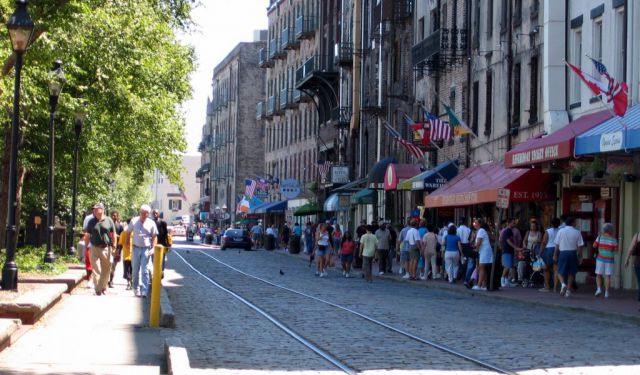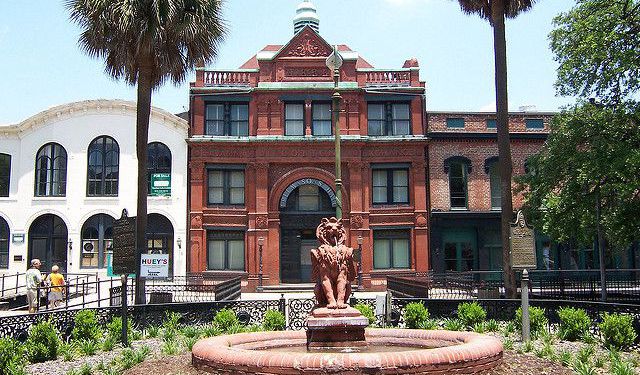
Savannah Introduction Walking Tour (Self Guided), Savannah
Savannah may not be the whole of Sweet Georgia, but no Georgia is complete without Savannah, that's for sure.
This coastal city is named after the river upon which it stands, whose name is likely to be the variant pronunciation of “Shawnee”, the Native American tribe which inhabited the area in the 1680s. Alternatively, it could have derived from the Spanish “sabana”, referring to the extensive marshlands surrounding the river.
Founded in 1733, Savannah is the oldest city in Georgia, and initially it served as the British colonial capital of the Province of Georgia, which later became a U.S. state. A strategic port in the American Revolution and during the Civil War, Savannah grew quite prosperous during the 19th century.
Its large population of oak trees, widely used in shipbuilding in the 1800s, earned Savannah the nickname, "Forest City". Another title that is still widely applied to it, the "Hostess City of the South," pays tribute to Savannah's epitomizing the American South.
Nowadays an important industrial center and Atlantic seaport, Savannah attracts millions of visitors each year. The city center, one of the largest National Historic Landmark Districts in the U.S., is renowned for its antebellum architecture, horse-drawn carriages, cobblestone squares, and manicured parks, including Forsyth Park, shaded by oak trees covered in Spanish moss.
Home to one of the main local landmarks, such as the Gothic-Revival Cathedral of St. John the Baptist, the picturesque historic district of Savannah is filled with numerous historic buildings, such as the Telfair Academy of Arts and Sciences (which is one of the first public museums in the American South), the First African Baptist Church (one of the oldest African-American Baptist congregations in the United States) and more.
To explore these and other attractions of the city reputed for its Southern charm and hospitality, follow our introductory walk and get an ultimate experience of Savannah, Georgia!
This coastal city is named after the river upon which it stands, whose name is likely to be the variant pronunciation of “Shawnee”, the Native American tribe which inhabited the area in the 1680s. Alternatively, it could have derived from the Spanish “sabana”, referring to the extensive marshlands surrounding the river.
Founded in 1733, Savannah is the oldest city in Georgia, and initially it served as the British colonial capital of the Province of Georgia, which later became a U.S. state. A strategic port in the American Revolution and during the Civil War, Savannah grew quite prosperous during the 19th century.
Its large population of oak trees, widely used in shipbuilding in the 1800s, earned Savannah the nickname, "Forest City". Another title that is still widely applied to it, the "Hostess City of the South," pays tribute to Savannah's epitomizing the American South.
Nowadays an important industrial center and Atlantic seaport, Savannah attracts millions of visitors each year. The city center, one of the largest National Historic Landmark Districts in the U.S., is renowned for its antebellum architecture, horse-drawn carriages, cobblestone squares, and manicured parks, including Forsyth Park, shaded by oak trees covered in Spanish moss.
Home to one of the main local landmarks, such as the Gothic-Revival Cathedral of St. John the Baptist, the picturesque historic district of Savannah is filled with numerous historic buildings, such as the Telfair Academy of Arts and Sciences (which is one of the first public museums in the American South), the First African Baptist Church (one of the oldest African-American Baptist congregations in the United States) and more.
To explore these and other attractions of the city reputed for its Southern charm and hospitality, follow our introductory walk and get an ultimate experience of Savannah, Georgia!
How it works: Download the app "GPSmyCity: Walks in 1K+ Cities" from Apple App Store or Google Play Store to your mobile phone or tablet. The app turns your mobile device into a personal tour guide and its built-in GPS navigation functions guide you from one tour stop to next. The app works offline, so no data plan is needed when traveling abroad.
Savannah Introduction Walking Tour Map
Guide Name: Savannah Introduction Walking Tour
Guide Location: USA » Savannah (See other walking tours in Savannah)
Guide Type: Self-guided Walking Tour (Sightseeing)
# of Attractions: 11
Tour Duration: 2 Hour(s)
Travel Distance: 3.7 Km or 2.3 Miles
Author: hollyg
Sight(s) Featured in This Guide:
Guide Location: USA » Savannah (See other walking tours in Savannah)
Guide Type: Self-guided Walking Tour (Sightseeing)
# of Attractions: 11
Tour Duration: 2 Hour(s)
Travel Distance: 3.7 Km or 2.3 Miles
Author: hollyg
Sight(s) Featured in This Guide:
- Forsyth Park
- Bull Street
- Cathedral of St. John the Baptist
- Owens-Thomas House and Slave Quarters
- Telfair Academy
- Ships of the Sea Maritime Museum
- First African Baptist Church
- City Market
- City Hall
- River Street
- River Street Market Place
1) Forsyth Park (must see)
Forsyth Park to Savannah, Georgia is pretty much what Central Park is to New York City or Lincoln Park to Chicago. Occupying 30 acres of land in the city's Historic District, this park was laid out in 1851 and named for the then Governor of the state, John Forsyth.
The park's centerpiece is undoubtedly its most famous asset, the Forsyth Fountain. Modeled after the fountains at Place de la Concorde square in Paris, France, it was added in 1858. More recently, this fountain has made appearance in a number of movies like 'Cape Fear', 'Forrest Gump', and 'Midnight in the Garden of Good and Evil'.
Among other amenities here, visitors will find plenty of walking paths, a children's play area, a fragrant "Garden for the Blind" (where all of the plantings are chosen for their scent, rather than their appearance), tennis and basketball courts, areas for soccer and frisbee, a half-shell theater, cafe, and more. The park is also home to the Savannah Shamrocks Rugby Club, and contains several monuments to historic personalities, including the one commemorating those killed in the Civil War, the bloodiest armed conflict in American history.
From time to time, the park hosts musical events, such as Savannah Symphony and Jazz Festival, as well as a Farmers Market held every Saturday, and free movie screenings every few months. The place is very family-friendly, ideally suited for those loving to throw and kick some ball or simply relax with a picnic and blanket under the shade of an oak tree. Architecture buffs will definitely want to take the sidewalk along the park to view the homes across from it.
The park's centerpiece is undoubtedly its most famous asset, the Forsyth Fountain. Modeled after the fountains at Place de la Concorde square in Paris, France, it was added in 1858. More recently, this fountain has made appearance in a number of movies like 'Cape Fear', 'Forrest Gump', and 'Midnight in the Garden of Good and Evil'.
Among other amenities here, visitors will find plenty of walking paths, a children's play area, a fragrant "Garden for the Blind" (where all of the plantings are chosen for their scent, rather than their appearance), tennis and basketball courts, areas for soccer and frisbee, a half-shell theater, cafe, and more. The park is also home to the Savannah Shamrocks Rugby Club, and contains several monuments to historic personalities, including the one commemorating those killed in the Civil War, the bloodiest armed conflict in American history.
From time to time, the park hosts musical events, such as Savannah Symphony and Jazz Festival, as well as a Farmers Market held every Saturday, and free movie screenings every few months. The place is very family-friendly, ideally suited for those loving to throw and kick some ball or simply relax with a picnic and blanket under the shade of an oak tree. Architecture buffs will definitely want to take the sidewalk along the park to view the homes across from it.
2) Bull Street (must see)
Bull Street is the main artery of Savannah’s downtown area, stretching all the way from the Starland neighborhood through Historic District. A section between Forsyth Park and the City Hall is the showroom of the city's history and beauty. Walking here you will pass via five of Savannah's iconic squares, such as Johnson Square, Wright Square, Chippewa Square, Madison Square, and Monterey Square, located precisely two blocks away from each other down the road.
This thoroughfare offers some of Savannah’s best shopping experiences, not to mention lots of other delights! The long stretch between Forsyth and the river is a home to some of the best restaurants in town.
In particular, make sure to explore the BULL STREET TACO (open Monday through Saturday, from 11am–10pm), which is a hip artsy spot with lots of contemporary artwork and vintage photos on the walls. It has a few tables inside, a bar, and a nice patio outside, where many people dine in the warmer months. Most of the drinks at the bar are tequila-based; however, their main event, undoubtedly, is the street tacos!
As you stroll down the road under the moss and oak trees past the numerous boutiques, eateries, and historic homes, keep an eye on memorial plaques here and there. The genuine feeling of presence in the Old South will come over you instantly.
This thoroughfare offers some of Savannah’s best shopping experiences, not to mention lots of other delights! The long stretch between Forsyth and the river is a home to some of the best restaurants in town.
In particular, make sure to explore the BULL STREET TACO (open Monday through Saturday, from 11am–10pm), which is a hip artsy spot with lots of contemporary artwork and vintage photos on the walls. It has a few tables inside, a bar, and a nice patio outside, where many people dine in the warmer months. Most of the drinks at the bar are tequila-based; however, their main event, undoubtedly, is the street tacos!
As you stroll down the road under the moss and oak trees past the numerous boutiques, eateries, and historic homes, keep an eye on memorial plaques here and there. The genuine feeling of presence in the Old South will come over you instantly.
3) Cathedral of St. John the Baptist (must see)
Back in the early days of America, the Roman Catholics were banned from settling in the South out of fear of their potential loyalty to the Spanish crown and possible secession of the southern colonies from the English-controlled North. As a result, Savannah had no Catholic church until 1799, when the French migrants from Haiti, fleeing the French Revolution, established it for the first time. The Cathedral of Saint John the Baptist was begun in 1873. It was commissioned in 1896 upon the completion of the majestic twin spires and addition of stucco and whitewash coating to the brick structure.
The cathedral boasts a number of notable artistic and architectural features, including the Great Rose Window, a Gothic quatrefoil with the image of Saint Cecilia in the center. The windows radiating from the center also contain figures – of players of musical instruments. The Original Window of the Blessed Virgin Mary is one of the few to have survived the great fire that ravaged the city in 1898. The Transept Windows feature the assumption of Virgin Mary into heaven, surrounded by angels and saints. In addition to this, the church houses several murals dating from 1912, depicting saints and other religious figures with the encoded symbols indicating their lives and deaths.
Locals lovingly dub the cathedral "America's Sistine Chapel", referring to its amazing stained glass work, ceiling paintings, and altar. Lovely to look at, this fine piece of French Gothic architecture is like a free 'trip' to Europe, particularly impressive to those who have not traveled extensively outside of the U.S.
Whilst inside, spare some time for a guided tour of the building – you'll be glad that you did. Also, be sure to drop a few bills in the donation box at the exit, which is quite unique, and don't forget to turn the handle.
The cathedral boasts a number of notable artistic and architectural features, including the Great Rose Window, a Gothic quatrefoil with the image of Saint Cecilia in the center. The windows radiating from the center also contain figures – of players of musical instruments. The Original Window of the Blessed Virgin Mary is one of the few to have survived the great fire that ravaged the city in 1898. The Transept Windows feature the assumption of Virgin Mary into heaven, surrounded by angels and saints. In addition to this, the church houses several murals dating from 1912, depicting saints and other religious figures with the encoded symbols indicating their lives and deaths.
Locals lovingly dub the cathedral "America's Sistine Chapel", referring to its amazing stained glass work, ceiling paintings, and altar. Lovely to look at, this fine piece of French Gothic architecture is like a free 'trip' to Europe, particularly impressive to those who have not traveled extensively outside of the U.S.
Whilst inside, spare some time for a guided tour of the building – you'll be glad that you did. Also, be sure to drop a few bills in the donation box at the exit, which is quite unique, and don't forget to turn the handle.
4) Owens-Thomas House and Slave Quarters (must see)
The historic Owens–Thomas House in Savannah, Georgia is one of the finest examples of English Regency architecture in the United States.
The building was completed in 1819 to a design by William Jay, an English architect. His plan was to create a house aesthetically compatible to Bath, England, which is evident in the use of the Bath stone as well as in the sophisticated architectural detail that was meant to add a gentrifying physical ornament to the then-newly emerging Southern port of Savannah. The structure is notable for its early cast-iron side veranda with elaborate acanthus scroll supports on which the Marquis de Lafayette addressed the citizens of Savannah on his visit in 1825.
The house was originally named for its first owner, Richard Richardson, whose family had earned fortune as cotton merchants and bankers. In 1830, the mansion was purchased by the local attorney and politician, George Welshman Owens, and remained in his family for several decades until Owens' granddaughter, Margaret Thomas, bequeathed it to the Telfair Academy of Arts and Sciences, in 1951.
In 1976, the house was designated a National Historic Landmark. Complete with the Slave Quarters, which were uncovered and restored during renovations in the 1990s, the property is now a museum. Its collection contains furnishings and decorative arts from the English Regency period, including possessions of the Owens family dating from 1790 to 1840. Among other exhibits here are English Georgian and American Federal period furniture, early Savannah textiles, silver, Chinese Export porcelain, and 18th- and 19th-century art.
The museum's highlight, though, is the carriage house that once functioned as slave quarters – one of the earliest in existence and best preserved in the American South. Previously inhabited by servants like the nanny, cook, butler and other enslaved workers, the place features slave artifacts of the period.
Although architecturally insignificant, the Slave Quarters is culturally and historically important as the showcase of the African slaves' attempt to maintain their ethnic heritage. The ceiling of the building is painted haint blue, which was customarily used in Gullah culture to deter ghosts or other malevolent spirits.
In the courtyard you can see a small parterre garden designed in 1820 English-American style.
The place is open Sunday through Monday from 12–5pm; and Tuesday through Saturday from 10am–5pm.
Tip:
Museum tours go off every 15 minutes – so try to go with a smaller group!
You can also get a pass to see the Jepson Art Center and the Telfair Museum of Art for a single price of $20 in the space of one week.
The building was completed in 1819 to a design by William Jay, an English architect. His plan was to create a house aesthetically compatible to Bath, England, which is evident in the use of the Bath stone as well as in the sophisticated architectural detail that was meant to add a gentrifying physical ornament to the then-newly emerging Southern port of Savannah. The structure is notable for its early cast-iron side veranda with elaborate acanthus scroll supports on which the Marquis de Lafayette addressed the citizens of Savannah on his visit in 1825.
The house was originally named for its first owner, Richard Richardson, whose family had earned fortune as cotton merchants and bankers. In 1830, the mansion was purchased by the local attorney and politician, George Welshman Owens, and remained in his family for several decades until Owens' granddaughter, Margaret Thomas, bequeathed it to the Telfair Academy of Arts and Sciences, in 1951.
In 1976, the house was designated a National Historic Landmark. Complete with the Slave Quarters, which were uncovered and restored during renovations in the 1990s, the property is now a museum. Its collection contains furnishings and decorative arts from the English Regency period, including possessions of the Owens family dating from 1790 to 1840. Among other exhibits here are English Georgian and American Federal period furniture, early Savannah textiles, silver, Chinese Export porcelain, and 18th- and 19th-century art.
The museum's highlight, though, is the carriage house that once functioned as slave quarters – one of the earliest in existence and best preserved in the American South. Previously inhabited by servants like the nanny, cook, butler and other enslaved workers, the place features slave artifacts of the period.
Although architecturally insignificant, the Slave Quarters is culturally and historically important as the showcase of the African slaves' attempt to maintain their ethnic heritage. The ceiling of the building is painted haint blue, which was customarily used in Gullah culture to deter ghosts or other malevolent spirits.
In the courtyard you can see a small parterre garden designed in 1820 English-American style.
The place is open Sunday through Monday from 12–5pm; and Tuesday through Saturday from 10am–5pm.
Tip:
Museum tours go off every 15 minutes – so try to go with a smaller group!
You can also get a pass to see the Jepson Art Center and the Telfair Museum of Art for a single price of $20 in the space of one week.
5) Telfair Academy (must see)
The Telfair Academy is a historic neoclassical Regency-style mansion and another creation of William Jay in Savannah, one of the few of his surviving works. The mansion was built in 1818, originally as a family townhouse belonging to the Telfair family, and as such, was the former home of Alexander Telfair, the son of Revolutionary War patriot and Georgia governor, Edward Telfair.
In 1875 Alexander's sister, Mary, heir to the family fortune and last to bear the Telfair name, bequeathed the house, complete with its furnishings and family collections, to the Georgia Historical Society. After significant renovations, which included the addition of the Sculpture Gallery and the Rotunda, the venue opened to the public in 1886 as a free art museum, being the first art museum in the southeastern United States.
In 1976, the building was declared a National Historic Landmark.
Presently, this is one of three sites owned by Telfair Museums (the other two being the Owens-Thomas House and the new modern-art focused Jepson Center). The Telfair Academy contains two 19th-century period rooms and houses 19th- and 20th-century American and European art from its permanent collection, including paintings, works on paper, sculptures and decorative arts. In addition to these, the Academy houses artworks representing Savannah's history and those from native local artists.
Perhaps the most famous attraction here is the Bird Girl statue (relocated from Bonaventure Cemetery), which was made famous by the John Berendt novel, "Midnight in the Garden of Good and Evil".
In a sense, this place offers a great introduction to Savannah by way of depicting local life from the early 20th century, complemented by a broader selection of American impressionism, American portraiture, and the Ashcan school. Whilst inside, don't miss the upstairs room, holding impressive large-size paintings the likes of which can be found only in Chicago or New York.
In 1875 Alexander's sister, Mary, heir to the family fortune and last to bear the Telfair name, bequeathed the house, complete with its furnishings and family collections, to the Georgia Historical Society. After significant renovations, which included the addition of the Sculpture Gallery and the Rotunda, the venue opened to the public in 1886 as a free art museum, being the first art museum in the southeastern United States.
In 1976, the building was declared a National Historic Landmark.
Presently, this is one of three sites owned by Telfair Museums (the other two being the Owens-Thomas House and the new modern-art focused Jepson Center). The Telfair Academy contains two 19th-century period rooms and houses 19th- and 20th-century American and European art from its permanent collection, including paintings, works on paper, sculptures and decorative arts. In addition to these, the Academy houses artworks representing Savannah's history and those from native local artists.
Perhaps the most famous attraction here is the Bird Girl statue (relocated from Bonaventure Cemetery), which was made famous by the John Berendt novel, "Midnight in the Garden of Good and Evil".
In a sense, this place offers a great introduction to Savannah by way of depicting local life from the early 20th century, complemented by a broader selection of American impressionism, American portraiture, and the Ashcan school. Whilst inside, don't miss the upstairs room, holding impressive large-size paintings the likes of which can be found only in Chicago or New York.
6) Ships of the Sea Maritime Museum
Founded in 1966, the Ships of the Sea Maritime Museum is dedicated to documenting Savannah's maritime heritage. The museum has been located in the William Scarborough mansion since 1994, and is a home to the vast collection of nautical-themed artwork, spread across nine galleries, including carvings, paintings, knotwork and scrimshaw, as well as ship models.
The latter include models of the USS Savannah, the first steamship to cross the Atlantic; the HMS Anne, which carried James Oglethorpe, the founder of Georgia, along with other first settlers of the colony, in 1732; The Wanderer, the last documented ship to bring a cargo of slaves from Africa to the United States, in 1858; and the RMS Titanic, which sank on her maiden voyage in 1912.
In many ways, however, the museum is overshadowed by the magnificent William Scarborough mansion itself, that is currently restored to its original early 19th-century appearance. One of the earliest examples of Greek Revival style in the city, this mansion was built in 1819, designed by the famed English architect, William Jay. The building was commissioned by William Scarborough, president of the Savannah Steamship Company and one of the principal owners of the USS Savannah.
Soon after, it was the focal point of colorful festivities during President James Monroe's visit to the city in 1819 and eventually became a center of Savannah's social life.
The two-story house features Roman-style windows flanking the entrance and a monumental Doric portico with a fanlight overhead. It also boasts the largest gardens in the Savannah Historic District, spread over two acres, featuring mostly the plants native to the area. The gardens also provide venue for the Savannah Music Festival each year.
The latter include models of the USS Savannah, the first steamship to cross the Atlantic; the HMS Anne, which carried James Oglethorpe, the founder of Georgia, along with other first settlers of the colony, in 1732; The Wanderer, the last documented ship to bring a cargo of slaves from Africa to the United States, in 1858; and the RMS Titanic, which sank on her maiden voyage in 1912.
In many ways, however, the museum is overshadowed by the magnificent William Scarborough mansion itself, that is currently restored to its original early 19th-century appearance. One of the earliest examples of Greek Revival style in the city, this mansion was built in 1819, designed by the famed English architect, William Jay. The building was commissioned by William Scarborough, president of the Savannah Steamship Company and one of the principal owners of the USS Savannah.
Soon after, it was the focal point of colorful festivities during President James Monroe's visit to the city in 1819 and eventually became a center of Savannah's social life.
The two-story house features Roman-style windows flanking the entrance and a monumental Doric portico with a fanlight overhead. It also boasts the largest gardens in the Savannah Historic District, spread over two acres, featuring mostly the plants native to the area. The gardens also provide venue for the Savannah Music Festival each year.
7) First African Baptist Church (must see)
The First Colored Church of Savannah (renamed the First African Baptist Church in 1882) is the oldest continuously active African-American congregation in North America. It was formed in 1778 by George Liele, the first black man to be ordained by Baptists to preach in Georgia.
The present church was built by members of the congregation, among whom there were many slaves who, after laboring all day in the fields, would make bricks, lay mortar, and carve pews for the church (that are still in use even today!).
During the turbulent years of the Civil War, this temple was a haven for runaway slaves. The fugitives hid in a four-foot high space between the basement and foundation below, with 'air holes' still visible in the basement floor – in lack of better knowledge, some visitors today erroneously assume these holes to be part of an artistic design. Speaking of the design, worthy of note here are the beautiful stained glass windows depicting Liele and other early church leaders, installed in 1885.
During the 1960s, the First African Baptist Church of Savannah served as a base for the Civil Rights movement. Today, it houses a museum containing archives and memorabilia dated from the 18th century.
Those interested in history in general and that of Savannah in particular, should consider taking a guided tour of the church. The tour takes you through the main temple, upstairs, and in the basement where you can learn about the role of the Underground Railroad.
Guided tours are offered Tuesday through Saturday at 11am, 2pm, and 4pm; and on Sunday at 1pm.
The present church was built by members of the congregation, among whom there were many slaves who, after laboring all day in the fields, would make bricks, lay mortar, and carve pews for the church (that are still in use even today!).
During the turbulent years of the Civil War, this temple was a haven for runaway slaves. The fugitives hid in a four-foot high space between the basement and foundation below, with 'air holes' still visible in the basement floor – in lack of better knowledge, some visitors today erroneously assume these holes to be part of an artistic design. Speaking of the design, worthy of note here are the beautiful stained glass windows depicting Liele and other early church leaders, installed in 1885.
During the 1960s, the First African Baptist Church of Savannah served as a base for the Civil Rights movement. Today, it houses a museum containing archives and memorabilia dated from the 18th century.
Those interested in history in general and that of Savannah in particular, should consider taking a guided tour of the church. The tour takes you through the main temple, upstairs, and in the basement where you can learn about the role of the Underground Railroad.
Guided tours are offered Tuesday through Saturday at 11am, 2pm, and 4pm; and on Sunday at 1pm.
8) City Market (must see)
Originally centered on the site of today's Ellis Square, from 1733, Savannah's main marketplace was established as a wooden building where locals gathered for their groceries and services. By 1755, the market had turned into a center of local commerce and hub of all activity downtown; a place where fishermen and farmers would bring their goods to sell.
Over time, the building survived two fires (in 1796 and 1820) which ultimately destroyed it, and was replaced the following year with a single-storey structure. The latter was torn down also, shortly after the Civil War, and its place was taken by a brick building, erected in 1876, by architects Augustus Schwaab and Martin Phillip Muller.
Albeit praised as "roomy (the structure encompassed 33,000 square feet), and capable of being kept in the highest condition of cleanliness, with ample ventilation", the cost of construction "vastly exceeded expectations". Later excavations revealed weakened arches in the basement floor that required them to be replaced.
The market suffered severe damage from a hurricane in 1896, and was even closed at one point, in 1954. But today it thrives once again, stretching for a good two blocks between Ellis and Franklin squares.
The old 19th-century cotton warehouses, once fallen into disrepair, have been restored and renovated, and turned into bistros, art galleries, casual and upscale restaurants, antique stores, jewelry shops, bakeries, sweets and candy parlors, and other specialty outlets (there's even a daiquiri dispensary and a specialty coffee joint).
The newest attraction in the market complex is the American Prohibition Museum, which has 6,000 square feet of exhibition space, housing 13 galleries.
During the day and at night the historic place offers totally different experiences. In the evenings, visitors can enjoy jazz at local nightclubs or otherwise discover the "art and soul" of Savannah while being serenaded by local musicians.
Over time, the building survived two fires (in 1796 and 1820) which ultimately destroyed it, and was replaced the following year with a single-storey structure. The latter was torn down also, shortly after the Civil War, and its place was taken by a brick building, erected in 1876, by architects Augustus Schwaab and Martin Phillip Muller.
Albeit praised as "roomy (the structure encompassed 33,000 square feet), and capable of being kept in the highest condition of cleanliness, with ample ventilation", the cost of construction "vastly exceeded expectations". Later excavations revealed weakened arches in the basement floor that required them to be replaced.
The market suffered severe damage from a hurricane in 1896, and was even closed at one point, in 1954. But today it thrives once again, stretching for a good two blocks between Ellis and Franklin squares.
The old 19th-century cotton warehouses, once fallen into disrepair, have been restored and renovated, and turned into bistros, art galleries, casual and upscale restaurants, antique stores, jewelry shops, bakeries, sweets and candy parlors, and other specialty outlets (there's even a daiquiri dispensary and a specialty coffee joint).
The newest attraction in the market complex is the American Prohibition Museum, which has 6,000 square feet of exhibition space, housing 13 galleries.
During the day and at night the historic place offers totally different experiences. In the evenings, visitors can enjoy jazz at local nightclubs or otherwise discover the "art and soul" of Savannah while being serenaded by local musicians.
9) City Hall
Dominating Bay Street, the Savannah City Hall is a real eye-catcher, capped with a pretty gold-leaf-covered copper dome. The building was designed by acclaimed architect, Hyman Witcover, notable for several other creations in the Savannah area.
The construction lasted from 1904 to 1905, and was located on the site previously occupied by the City Exchange, which had been built in 1799 and was demolished in 1904. The project took place during the administration of Savannah Mayor Herman Myers, who described it as "a monument to the progressive spirit that marks the Savannah of today" that will “typify the 20th century Savannah, [the one] of indomitable energy and punishing progressiveness.”
The City Hall officially opened in 1906. It represents an example of Renaissance Revival architecture with an exterior clad in gray limestone and granite. On the inside, it has two elevators and the historic steps going down the old River Street which are interesting in their own right. Initial plans called for four statues of chariots to be placed on the tops of the building's four corners, but financial limitations prevented this.
Directly adjacent is a small canopy sheltering two cannons, which together compose the city's oldest monument. These are the Chatham Artillery Guns, presented to the local militia group of the same name by President George Washington during his one and only visit to town in 1791. Today, locals use the phrase "Chatham Artillery" differently, to refer to a particularly potent local punch recipe that mixes several hard liquors.
In 2014, the Georgia Historical Society erected at the City Hall a Georgia historical marker.
The construction lasted from 1904 to 1905, and was located on the site previously occupied by the City Exchange, which had been built in 1799 and was demolished in 1904. The project took place during the administration of Savannah Mayor Herman Myers, who described it as "a monument to the progressive spirit that marks the Savannah of today" that will “typify the 20th century Savannah, [the one] of indomitable energy and punishing progressiveness.”
The City Hall officially opened in 1906. It represents an example of Renaissance Revival architecture with an exterior clad in gray limestone and granite. On the inside, it has two elevators and the historic steps going down the old River Street which are interesting in their own right. Initial plans called for four statues of chariots to be placed on the tops of the building's four corners, but financial limitations prevented this.
Directly adjacent is a small canopy sheltering two cannons, which together compose the city's oldest monument. These are the Chatham Artillery Guns, presented to the local militia group of the same name by President George Washington during his one and only visit to town in 1791. Today, locals use the phrase "Chatham Artillery" differently, to refer to a particularly potent local punch recipe that mixes several hard liquors.
In 2014, the Georgia Historical Society erected at the City Hall a Georgia historical marker.
10) River Street (must see)
Paved with 200-year-old cobblestones, the historic River Street is a major commercial promenade running along the southern edge of the Savannah River in the heart of Savannah, Georgia. Its most well-known section extends from the Talmadge Memorial Bridge, then below City Hall and Yamacraw Bluff.
The area was once lined with cotton warehouses which were also used as holding cells for African slaves. The neighborhood saw a slow recovery from the 1818 yellow fever epidemic and, having been abandoned for over a century, was rediscovered only in the 1970s.
At a cost of $7 million, a new waterfront was unveiled in 1977 along with some 80,000 square feet of empty warehouse space converted into a colorful array of restaurants, cafés, craft shops, pubs, and art galleries. The half-mile-long pedestrian promenade, the John P. Rousakis Riverfront Plaza, is named for Savannah's longest-serving mayor (who was in office from 1970–1992).
Riverfront Plaza, as it is known today, is a popular destination for locals and tourists who come to buy souvenirs, contemplate the huge ships cruising on the river, or attend the numerous events and festivities throughout the year, including Saint Patrick's Day, the July 4th fireworks or New Year's Eve. Families are safe and welcome here, but energetic pub crawling remains a favorite pastime for most.
If you happen to take a leisurely stroll along the landscaped river walk, observe the Waving Girl and Olympic Cauldron statues, then explore the bluffs along the river on the old passageway of alleys, cobblestone walkways and bridges known today as Factor's Walk. You can also stop at the River Street Hospitality Center, which is adjacent to the Hyatt Regency hotel or spend some time looking at vendors selling their wares in the Market Place.
The area was once lined with cotton warehouses which were also used as holding cells for African slaves. The neighborhood saw a slow recovery from the 1818 yellow fever epidemic and, having been abandoned for over a century, was rediscovered only in the 1970s.
At a cost of $7 million, a new waterfront was unveiled in 1977 along with some 80,000 square feet of empty warehouse space converted into a colorful array of restaurants, cafés, craft shops, pubs, and art galleries. The half-mile-long pedestrian promenade, the John P. Rousakis Riverfront Plaza, is named for Savannah's longest-serving mayor (who was in office from 1970–1992).
Riverfront Plaza, as it is known today, is a popular destination for locals and tourists who come to buy souvenirs, contemplate the huge ships cruising on the river, or attend the numerous events and festivities throughout the year, including Saint Patrick's Day, the July 4th fireworks or New Year's Eve. Families are safe and welcome here, but energetic pub crawling remains a favorite pastime for most.
If you happen to take a leisurely stroll along the landscaped river walk, observe the Waving Girl and Olympic Cauldron statues, then explore the bluffs along the river on the old passageway of alleys, cobblestone walkways and bridges known today as Factor's Walk. You can also stop at the River Street Hospitality Center, which is adjacent to the Hyatt Regency hotel or spend some time looking at vendors selling their wares in the Market Place.
11) River Street Market Place
The embodiment of Savannah’s love of history, River Street Market Place represents an array of beautifully recreated sheds that once stood on this street, back in the mid 19th century.
The place is worth wandering through if enjoy the Savannah riverfront, especially while killing time waiting for a table at a nearby restaurant. Recognized as the most unique shopping destination in Savannah, this venue is set in a wonderfully relaxing area, with the river on one side and the cobblestone thoroughfare on the other.
It has over 70 booths altogether, containing artwork, gifts, and personalized items from around the globe. Pretty much every booth here has a vendor, and there is a ceiling overhead, so rain is not an issue. Among the most interesting things to check out are the wood burning and carved home décor designs, as well as the candles you could use as a lotion, made out of essential oils.
There are tons of other random, unique items, some handmade (such as jewelry, carvings, and wind chimes) and some pricey, but it's fine to walk through and see all the local culture anyway. And, just in case you get thirsty or fancy a bite to eat, there is a coffee, drinks and smoothies food cart right outside, with picnic tables to lounge on, should you be so inclined. The sweet tooth in you will definitely appreciate the delicious praline at the local candy shop or the honey store, as they are among the highlights.
The marketplace is rather small, so it doesn't take long to walk through. Highly recommended to those seeking to experience Southern charm, old-fashioned hospitality and shop in an open-air environment.
The place is worth wandering through if enjoy the Savannah riverfront, especially while killing time waiting for a table at a nearby restaurant. Recognized as the most unique shopping destination in Savannah, this venue is set in a wonderfully relaxing area, with the river on one side and the cobblestone thoroughfare on the other.
It has over 70 booths altogether, containing artwork, gifts, and personalized items from around the globe. Pretty much every booth here has a vendor, and there is a ceiling overhead, so rain is not an issue. Among the most interesting things to check out are the wood burning and carved home décor designs, as well as the candles you could use as a lotion, made out of essential oils.
There are tons of other random, unique items, some handmade (such as jewelry, carvings, and wind chimes) and some pricey, but it's fine to walk through and see all the local culture anyway. And, just in case you get thirsty or fancy a bite to eat, there is a coffee, drinks and smoothies food cart right outside, with picnic tables to lounge on, should you be so inclined. The sweet tooth in you will definitely appreciate the delicious praline at the local candy shop or the honey store, as they are among the highlights.
The marketplace is rather small, so it doesn't take long to walk through. Highly recommended to those seeking to experience Southern charm, old-fashioned hospitality and shop in an open-air environment.
Walking Tours in Savannah, Georgia
Create Your Own Walk in Savannah
Creating your own self-guided walk in Savannah is easy and fun. Choose the city attractions that you want to see and a walk route map will be created just for you. You can even set your hotel as the start point of the walk.
Historical Houses Walking Tour
Savannah, Georgia breathes history. You can feel it in the cobblestone alleyways and quaint squares dotting the city. An enchanting walk through the heart of Savannah's Historic District (one of the most carefully preserved in the United States) highlights an array of beautiful homes.
Saved by the forward-thinking residents from being bulldozed in the 1960s, these gorgeous structures (with... view more
Tour Duration: 2 Hour(s)
Travel Distance: 3.7 Km or 2.3 Miles
Saved by the forward-thinking residents from being bulldozed in the 1960s, these gorgeous structures (with... view more
Tour Duration: 2 Hour(s)
Travel Distance: 3.7 Km or 2.3 Miles
African-American Heritage Tour
The history of America has many themes, but the theme of African American history that has touched many the most is the theme of resilience. Indeed, African Americans' enduring strength and resilience in the face of adversity have been the subjects of many songs, books, and movies in recent years. Savannah, Georgia, whose African-American population makes up about 60 percent of total... view more
Tour Duration: 2 Hour(s)
Travel Distance: 4.4 Km or 2.7 Miles
Tour Duration: 2 Hour(s)
Travel Distance: 4.4 Km or 2.7 Miles
River Street Sightseeing and Shopping
The story of Savannah's River Street begins in 1733 with General James Edward Oglethorpe's landing on the bank of the Savannah River and founding the British colony of Georgia. Today, the cobble-stoned River Street caters to a variety of interests, combining the rustic beauty of the past with the energy of the present.
The half-mile-long promenade is one of the city's major... view more
Tour Duration: 1 Hour(s)
Travel Distance: 0.7 Km or 0.4 Miles
The half-mile-long promenade is one of the city's major... view more
Tour Duration: 1 Hour(s)
Travel Distance: 0.7 Km or 0.4 Miles
Savannah's Historical Churches
The conspicuous churches of various styles and denominations – Catholic, Baptist, Lutheran, Presbyterian, Unitarian, and Methodist – dot the cityscape of Savannah, Georgia, in abundance. With their spires reaching high, as if attempting to touch heaven, these churches stand like sacred sentinels, guarding the city's spiritual heritage and illuminating its architectural grandeur.
The... view more
Tour Duration: 2 Hour(s)
Travel Distance: 2.6 Km or 1.6 Miles
The... view more
Tour Duration: 2 Hour(s)
Travel Distance: 2.6 Km or 1.6 Miles
The Most Popular Cities
/ view all
